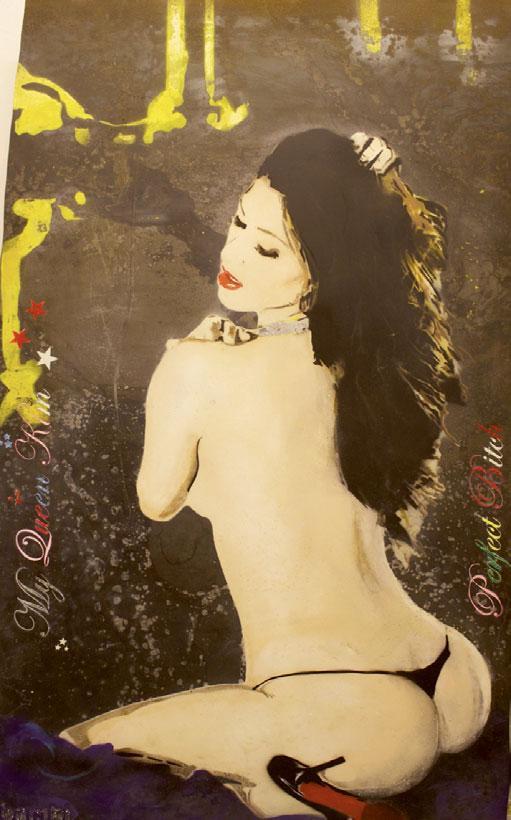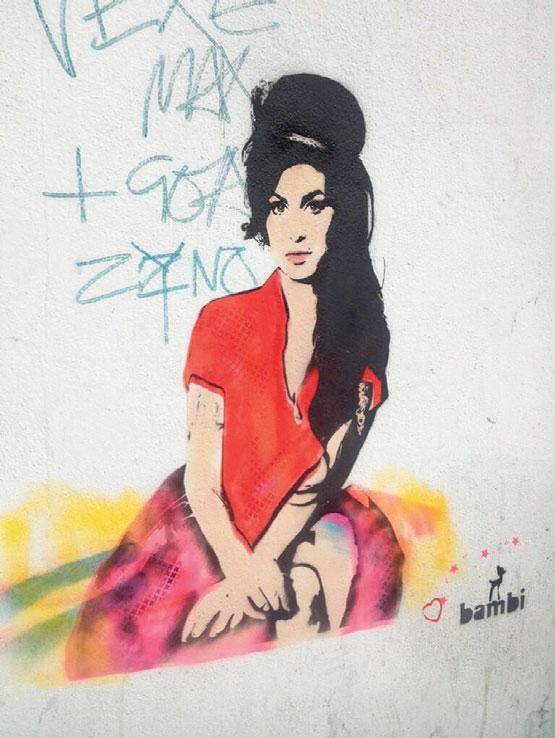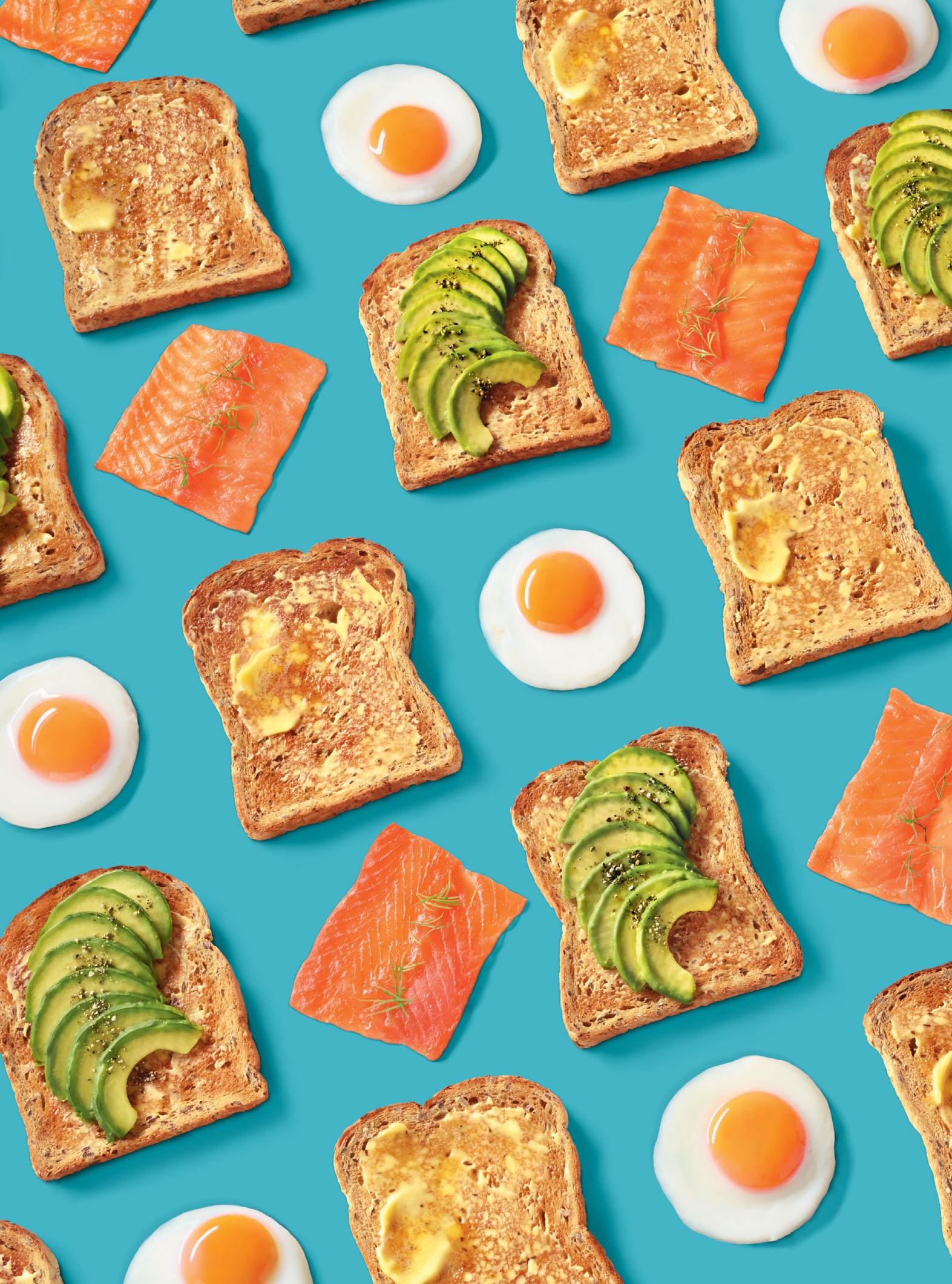
9 minute read
WHO IS BAMBI?


Advertisement
Hot stuff, from left: I’m Too Hot, at Walton Fine Arts; My Queen Kim, rumoured to have been commissioned by Kanye West in 2014 for Kim Kardashian
Amystery package is said to have been delivered to Boris Johnson’s offices this week. It contained Boris’ very own Bambi. Nope, the Mayor of London hasn’t adopted a doe-eyed spirit animal, Bambi is the highly coveted graffiti artist who recently painted a mobile installation of the Mayor as Winston Churchill. Dubbed the ‘female Banksy’ for her stencil designs and secret identity, her pop artinspired picture is said to have cost Johnson a five-figure sum.
If the rumours are true — and Boris’ office claims not to know either way — the Mayor wouldn’t be the first to invest in a work by the mysterious artist. Harry Styles, Adele and Robbie Williams all own one. Rihanna is said to have splashed out on a portrait of her friend Cara Delevingne early last year. Kanye West was reported to have commissioned a Bambi stencil of Kim Kardashian posing in a thong for her wedding present, while Angelina Jolie recently snapped up a portrait of 1950s pin-up Bettie Page for her French château.
Like Banksy, Bambi shies away from inter- views. But according to her agent, Lenny Villa of Villa Framing in Caledonian Road, Jolie has just commissioned the graffiti artist to create an original portrait of her husband Brad Pitt. The couple apparently invited Bambi over to do a sitting, but, keen to protect her identity, she refused, insisting Pitt send her
In the herd Buyers of Bambi’s artworks include (from left) Rihanna, Kanye West, Harry Styles and Angelina Jolie a photo instead. Similarly, when Styles asked her to paint a mural in the gallery he plans to install in his £3m Hampstead home, the artist turned him down. ‘She would never go into someone’s house,’ laughs Villa. ‘Not even Brad Pitt’s or Harry Styles’.’
This might sound like audacious behaviour for a little-known North London graffiti artist, but Bambi — whoever she is — can increasingly afford to call the shots. The priciest Bambi originals to sell through galleries are currently on the market for between £25,000 and £30,000, with prints — which generally run in sets of 75 — going for between £450 and £3,000. Kate Moss reportedly paid around £50,000 for a portrait of herself, one of the most expensive Bambi sales on record.
How to explain the appeal? For one thing, the works are likely to look a lot more cheerful on your wall than any Francis Bacon — they’re bold and colourful, zeitgeisty and sexy. Her paintings have been auctioned alongside the works of Tracey Emin and Damien Hirst. At a 2013 joint show with Banksy, Gary Barlow, Louis Walsh and Ringo Starr were all in attendance. Barlow and Starr seemed more interested in Bambis than Banksys, each taking one of her artworks home.
‘HER WORK IS BEAUTIFULLY PAINTED, HAS AN EDGE TO IT AND, DARE I SAY IT, A SAUCINESS’ Julian Hartnoll, art dealer
Julian Hartnoll, an established London dealer who usually sells Pre-Raphaelites, says he fell instantly in love with the graffiti work when he first saw it four years ago. He describes it as ‘Warhol for Islington’ and immediately invested because ‘her work is beautifully painted, has an edge to it and, dare I say it, a sauciness’. The common thread running through all of Bambi’s street work is that it’s sharp, poppy and political.
It’s also staunchly British in subject matter. ‘The technique is beautifully handled — one can’t fault it as one can with so many other street artists,’ says
Hartnoll. Bambi’s stencils started springing up on the streets of North London in 2010. There was Hero to Zero on a wall in Belsize Park, a striking image of an Afghan war hero returned to Britain, pictured in tracksuit and trainers with a bull terrier on a leash. The following year saw I’m Too Hot for My Burka appear (it can still be seen in Old Street, near the Cargo nightclub) as a response to then French President Nicolas Sarkozy’s ban on the hijab.
Bambi’s original gallerist is Michael Sakhai of Walton Fine Arts in Knightsbridge — the pair met five years ago when Bambi walked into his gallery and introduced herself and her work. This was early 2010 and, at the time, she was virtually unknown. Sakhai speaks particularly fondly of the Burka piece. ‘We thought it would cause a lot of controversy, but it was only met with enthusiasm,’ he says of the image, which features a bikini-clad woman in thigh-high socks, with no burka in sight.
But the artist’s most famous work is arguably her stencil portrait of Amy Winehouse, which popped up on a wall in Camden, shortly after the singer’s death in 2011. As is always the danger with street art, it was defaced, but the image has been restored and is now behind Perspex. (This is common practice with valuable works — some Banksys are similarly protected.) A new Amy picture appeared in another Camden street in 2013, at the time when the late singer would have turned 30.
While rumours swirl around, Bambi has gone to great lengths to remain anonymous. Spray-painting a public wall is technically vandalism and is punishable with hefty fines and jail time under the UK’s Criminal Damage Act.


On the street Boris Churchill at an Islington bus stop, 2015; Amy 2013, in Camden
is intentional; it wouldn’t be surprising if the mischievous artist planted a few red herrings to throw us off the track. It’s also possible that her agent has thrown a little fuel on the fire to create a bigger buzz around the artist’s identity — you get the idea he rather likes the intrigue. In fact, Villa claims that the main reason she’s anonymous is because, if people knew who she really was, they would comment that it’s easy for her to sell works, especially to other celebrities. Rather, her foremost passion, he says, has always been painting pictures.
Sakhai says that, as attention has snowballed over the past few years, it’s become incredibly difficult for him to see Bambi on a regular basis — ‘mostly because she’s worried someone might take a photograph of her’. As a consequence, their meetings are always clandestine, never at the gallery. But Villa, who fondly describes Bambi as his ‘wife number two’, speaks to the artist on the phone every day or two, and can confirm that she’s still living in the capital.
It has been claimed that Bambi is formally trained, having studied at Central Saint Martins art college. She’s thought to be a Londoner, born in Islington, and she’s said to have a penchant for Agent Provocateur lingerie. Others say she might be famous foremost as a recording artist. Villa is quick to back this up. He reveals that she’s still making music, with a song recently in the charts. ‘She’s a great singer,’ he gushes. ‘Probably one of the top ten singers in England, Europe or even the world.’ The best guesses so far have been M.I.A., Paloma Faith and Geri Halliwell, but none of these quite adds up. Perhaps this
Lenny Villa, Bambi’s agent
Said to be inspired by Andy Warhol, the American neo-expressionist artist and musician Jean-Michel Basquiat and Keith Haring, the mural-painting AIDS activist of the 1980s, Bambi’s aesthetic has a timelessness to it. ‘Every time we have a meeting it brings goose pimples into the atmosphere,’ says Sakhai, who describes Bambi as a ‘true classic artist’ and ‘an extremely innovative, creative person’.
During the past year and a half, Sakhai has seen a greater focus on iconic pop imagery in Bambi’s work. There are images of Elvis and Marilyn Monroe, and a liberal use of diamond dust, a glitter material made of finely ground glass. ‘Pop by definition is mass and she wants as many people as possible to like her — as most artists do,’ says Sakhai. He’s sold what he thinks might be more than 1,000 Bambi pieces. He reels off the private collectors who have Bambi works, casually mentioning that the royal families of Bahrain, Saudi Arabia and Kuwait have all bought ‘more than one’ from him. ‘When we work with big collectors they don’t just buy one piece,’ he adds. ‘It’s these kinds of people that exacerbate the collectability of an artist.’
At the hint that the guerrilla graffiti artist has chosen to sell out, Sakhai is quick to remind critics that ‘her works are special and they’re not mass-produced’. Her limited print runs, for example, are generally fewer and farther between than Banksy’s. Villa staunchly maintains that she’s driven by a ‘passion for art’, that she’s ‘obsessed with painting’ and that she is ‘politically motivated by things that upset her’. Earlier this year, after the Charlie Hebdo killings, Bambi was spotted spraying an image of Bruce Lee on a wall: he had the words ‘Je Suis Charlie’ on his T-shirt.
‘She has decoys and lookouts helping her,’ says Villa of her evenings spraying. ‘It’s like an SAS mission: it’s done with military precision.’ He mumbles something about how Bambi will get upset if he divulges too much about her process. All her confidantes are, after all, entrusted with the responsibility of keeping her business a secret. Villa even sounds a little panicked after he blurts out that, when Bambi is tagging in the early hours of the morning, she has a team of eight or nine friends, some of whom are also known musicians.
While the recent availability of print editions is quickly opening up the artist’s audience, allowing a new wave of buyers to purchase a slice of the Bambi pie, it’s her street work that fuels the celebrity machine. It might be tantalising to try to find out who she is, but it’s also easy to understand why her priority is to safeguard her identity. After all, that’s what allows her to continue doing what she does best on London’s beckoning walls. If you are desperate to catch her, though, we heard a whisper going round that she’ll soon be tagging the walls of London Zoo. The message? That you shouldn’t cage an animal. Especially, it would seem, not a doe-eyed little deer. ES













